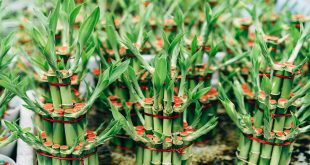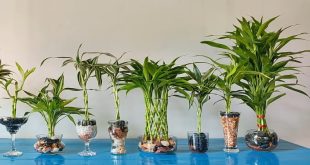Your lucky bamboo stalk is turning yellow due to overwatering or inadequate light. If you’ve noticed yellowing in your lucky bamboo stalk, it could either be a result of overwatering or a lack of sufficient light.
These two factors are the most common causes of yellowing in lucky bamboo. Overwatering can lead to root rot and yellowing of the stalk, while inadequate light can result in chlorophyll deficiency, causing the stalk to turn yellow. By adjusting your watering routine and ensuring your lucky bamboo gets enough light, you can prevent further yellowing and maintain its vibrant green color.
The Significance Of Lucky Bamboo In Feng Shui
Lucky bamboo is a beloved houseplant that has become increasingly popular in recent years, particularly among those who practice feng shui. This small, elegant plant is often seen adorning homes and offices, bringing not only a touch of greenery but also positive energy and good fortune.
We will delve into the significance of lucky bamboo in feng shui and explore why it is essential to maintain its health for optimal positive energy flow.
Explanation Of The Symbolism Behind Lucky Bamboo In Feng Shui
Lucky bamboo holds deep symbolism in feng shui, representing abundance, prosperity, and growth. Its vertical shape is reminiscent of the strong and steady growth of bamboo stalks in nature, while its vibrant green color embodies vitality and good health. The number of stalks bundled together also carries significance in feng shui.
For instance, three stalks are believed to bring happiness, longevity, and wealth, while five stalks attract positive energy and overall balance. Understanding the symbolism behind lucky bamboo allows us to harness its energy and make the most of its auspicious qualities.
Importance Of Maintaining The Health Of Lucky Bamboo For Positive Energy Flow
To fully benefit from the positive energy that lucky bamboo brings, it is crucial to ensure its health and vitality. Here are some reasons why maintaining the health of your lucky bamboo is vital in feng shui:
- Good energy flow: A thriving lucky bamboo plant promotes the smooth flow of positive energy, known as chi, throughout its surroundings. It purifies the air and creates a harmonious environment, fostering well-being and balance.
- Enhanced prosperity: In feng shui, healthy plants are believed to attract abundance and prosperity. By taking care of your lucky bamboo, you are not only nurturing its well-being but also inviting good fortune and financial success into your life.
- Symbolic representation: A yellowing or withering lucky bamboo can be seen as an indication of stagnant or negative energy. By keeping your plant vibrant and green, you are symbolically promoting growth, positivity, and the continuous flow of positive energy in your space.
- Emotional well-being: Having a flourishing lucky bamboo plant can have a positive impact on your emotional well-being. The vibrant energy it radiates can uplift moods, reduce stress, and create a sense of tranquility – all essential elements for a balanced and harmonious living or working space.
By understanding the symbolism of lucky bamboo and the importance of maintaining its health, you can harness the positive energy it brings and create a welcoming, auspicious atmosphere in your home or office. Let’s now explore some practical tips on how to keep your lucky bamboo thriving and vibrant.
Understanding The Causes Of Yellowing Lucky Bamboo Stalks
Lucky bamboo is a popular indoor plant known for its attractive appearance and symbolism of good luck. However, if you’ve noticed your lucky bamboo stalk turning yellow, it can be a cause for concern. Yellowing stalks can indicate that something is not quite right with your plant’s health.
In this blog post, we will delve into the possible causes of yellowing lucky bamboo stalks and provide you with the necessary knowledge to address these issues and ensure the well-being of your plant.
Factors That Contribute To Yellowing Of Lucky Bamboo Stalks:
- Overwatering: One of the most common mistakes made when caring for lucky bamboo is overwatering. This can lead to the roots becoming waterlogged and deprived of oxygen, causing the stalks to turn yellow.
- Insufficient light: Just like any other plant, lucky bamboo requires an adequate amount of light to thrive. Insufficient light can impede its growth and result in yellowing stalks. Understanding the lighting needs of your lucky bamboo and providing it with the right amount of light is crucial for its overall health.
- Low humidity levels: Lucky bamboo is native to rainforest environments, where humidity levels are high. When exposed to dry air, such as in an air-conditioned room, the plant may struggle and display yellowing stalks. Maintaining an appropriate level of humidity can help prevent this issue.
By understanding the causes mentioned above and taking appropriate action, you can prevent yellowing and ensure the longevity of your lucky bamboo plant. Remember to strike a balance with watering, provide adequate light, and consider increasing the humidity levels if necessary.
Taking good care of your lucky bamboo will not only restore its vibrant green color but also bring you good fortune and positive energy.
Recognizing The Signs And Symptoms Of A Sick Lucky Bamboo Plant
Lucky bamboo is a popular indoor plant known for its elegant appearance and believed to bring good luck and positive energy. However, if you notice your lucky bamboo stalk turning yellow, it’s essential to recognize the signs and symptoms of a sick plant.
Understanding these indicators will help you take appropriate measures to revive your lucky bamboo and ensure its well-being. In this section, we will discuss the three key signs of trouble: yellowing of leaves and stalks, leaf curling and browning, and stunted growth and wilting.
Yellowing Of Leaves And Stalks: An Obvious Sign Of Trouble
- Yellowing of leaves and stalks is a clear indication that your lucky bamboo is not receiving adequate care or is facing environmental stress.
- It may indicate overwatering, underwatering, exposure to direct sunlight, or unhealthy water quality.
- Factors like extreme temperatures, drafts, or excessive fertilizer can also lead to yellowing of the plant.
Leaf Curling And Browning: Additional Indications Of Poor Health
- Leaf curling and browning are additional signs that your lucky bamboo is in distress.
- Curling leaves may suggest pest infestation, improper watering, or excessively dry air.
- Browning of the leaves can be caused by overexposure to direct sunlight or inadequate humidity.
Stunted Growth And Wilting: Identifying Advanced Stages Of Distress
- Stunted growth and wilting indicate advanced stages of distress in your lucky bamboo plant.
- Improper light conditions, root rot due to overly wet conditions, or inadequate nutrients can lead to stunted growth.
- Wilting can be a result of underwatering, overfertilizing, or insufficient root space.
Recognizing these signs and symptoms of a sick lucky bamboo plant is crucial to its overall health and longevity. By understanding the underlying causes, you can address the issues promptly and provide the necessary care. In the following sections, we will explore each of these signs in more detail and provide useful tips on how to resolve the problems to restore your lucky bamboo’s vibrant and healthy appearance.
So let’s dive in and get to the root of the issue to bring back the luck and beauty to your lucky bamboo plant.
How To Revive Your Yellowing Lucky Bamboo Plant
Start With Proper Assessment And Diagnosis Of The Problem
Is your once vibrant and lush lucky bamboo plant suddenly turning yellow and looking rather sad? Don’t worry, as this common issue can be easily resolved with the right care and attention. The first step in reviving your yellowing lucky bamboo plant is understanding the root cause of the problem.
By properly assessing and diagnosing the issue, you can take the necessary steps to nurse your plant back to health.
Here are a few key points to consider in assessing your yellowing lucky bamboo plant:
Examine the leaves: Take a close look at the leaves of your plant. Are they fully yellow or just the tips? This can help determine if the problem lies in the roots or if it’s a watering issue.
Check the roots: Gently remove your lucky bamboo from its container and inspect the roots. Healthy roots should be firm and white, while decaying roots will appear brown or mushy.
Consider the environment: Evaluate the conditions your plant is exposed to. Is it getting enough light and humidity? Is the temperature too high or too low? These factors can play a significant role in plant health.
Adjusting Watering Regimen: Tips For Finding The Right Balance
Watering your lucky bamboo plant is a delicate balancing act. Too much or too little water can lead to yellowing leaves and a decline in overall plant health. Here are some tips to help you find the perfect watering regimen for your lucky bamboo:
- Water quality: Use filtered or distilled water to prevent the accumulation of minerals or chlorine, which can harm the plant.
- Watering frequency: Lucky bamboo prefers consistently moist soil, so water it when the top inch of soil feels dry to the touch. Avoid letting the plant sit in standing water, as this can lead to root rot.
- Proper drainage: Ensure that your plant’s container has drainage holes to allow excess water to escape. If your lucky bamboo is in a vase filled with water, change the water every two weeks to prevent stagnation.
- Adjusting the amount: If the leaves are turning yellow at the tips, it may indicate an overwatering issue. Reduce the amount of water given to your plant and monitor its response.
Providing Adequate Light: Creating Optimum Conditions For Growth
Lucky bamboo thrives in bright, indirect light. Inadequate lighting can contribute to yellowing leaves and stunted growth. Here’s how you can provide your plant with the right amount of light:
- Indirect sunlight: Place your lucky bamboo near a window where it can receive bright, filtered light without direct exposure to harsh rays. Avoid placing it in a spot with intense sunlight, as this can scorch the leaves.
- Rotate the plant: To ensure even light distribution, rotate your lucky bamboo every few weeks. This helps prevent one side from receiving more light than the other.
- Artificial lighting: If you have limited natural light in your space, consider using artificial grow lights. These lights mimic the spectrum of natural sunlight and can provide the necessary light intensity for your plant.
Increasing Humidity: Simple Methods To Increase Moisture Levels
Lucky bamboo plants thrive in a moderately humid environment, so low humidity levels can contribute to yellowing leaves. Here are some simple methods to increase the moisture levels around your plant:
- Grouping plants together: Grouping your lucky bamboo with other houseplants can create a microclimate with higher humidity levels.
- Pebble tray: Place a shallow tray filled with water and pebbles near your plant. As the water evaporates, it increases the humidity around the plant.
- Misting: Use a spray bottle filled with water to mist the leaves of your lucky bamboo regularly. This provides a temporary boost in humidity.
By following these simple steps and making adjustments to the watering, lighting, and humidity levels, you can revive your yellowing lucky bamboo plant and bring back its vibrancy. Remember to regularly assess and monitor your plant’s condition to ensure its continued health and beauty.
Preventative Measures To Keep Your Lucky Bamboo Healthy
Are you a proud owner of a lucky bamboo plant? Have you noticed that one or more of the stalks are turning yellow? Don’t fret! This blog post will explore the reasons behind this phenomenon and offer preventative measures to keep your lucky bamboo healthy.
By implementing the following tips, you’ll be able to maintain the vibrant green appearance of your beloved plant.
Choosing The Right Container And Soil For Lucky Bamboo
- Select a container that is tall and narrow to support the tall growth of lucky bamboo.
- Ensure the container has adequate drainage holes to prevent waterlogging.
- Use well-draining soil or a specialized lucky bamboo soil mix.
- Avoid using regular potting soil, as it retains too much moisture, leading to root rot.
Setting Up An Ideal Location For Your Lucky Bamboo Plant
- Place your lucky bamboo in a location with bright, indirect sunlight.
- Avoid exposing it to direct sunlight, as it can scorch the leaves.
- Keep the plant away from drafts, air conditioners, or heating vents, as extreme temperature changes can stress the plant.
Regular Cleaning And Maintenance Routines For Optimal Growth
- Dust the leaves of your lucky bamboo regularly to allow maximum light absorption.
- Use a soft cloth or a feather duster to gently wipe away any accumulated dust.
- Keep the water in the container clean by replacing it with fresh, chlorine-free water every two to four weeks.
Monitoring Potential Stressors And Preventive Measures
- Avoid overwatering your lucky bamboo, as excessive moisture can lead to root rot and yellowing leaves. Only water the plant when the top inch of soil feels dry to the touch.
- Ensure the humidity levels are adequate by placing the container on a tray filled with water and pebbles.
- Be cautious of fluoridated or chlorinated water, as it can harm the plant. Use mineral water or let tap water sit overnight to allow chlorine to dissipate.
- If you notice any signs of pest infestation, such as spider mites or aphids, take prompt action by using an appropriate insecticidal soap or neem oil spray.
By following these preventative measures, you can give your lucky bamboo the care it deserves and enjoy its beauty for years to come. Paying attention to the container and soil, providing an ideal location, maintaining cleanliness, and monitoring potential stressors will help ensure the health and vibrancy of your lucky bamboo plant.
Troubleshooting Common Problems Faced By Lucky Bamboo Owners
Dealing With Fungal Infections And Pest Infestations
Fungal infections and pest infestations are common problems faced by lucky bamboo owners. These issues can quickly turn a healthy green stalk into a yellowing and wilting one. To overcome these challenges, consider the following tips:
- Ensure proper air circulation around your lucky bamboo to prevent fungal infections. Avoid placing it in humid or stagnant areas.
- If you notice signs of fungus, such as white powdery spots on the leaves or stems, remove the affected parts immediately. Wipe down the remaining healthy stalks with a mild fungicide solution to prevent further spread.
- Keep an eye out for pests like spider mites or aphids that can cause yellowing of the leaves. Regularly inspect the plant and gently wipe the leaves with a damp cloth to remove any pests.
- In severe infestations, consider using an organic insecticidal soap or neem oil spray to eliminate pests. Follow the instructions on the product carefully to ensure safe usage.
Tips For Handling Over-Fertilizing And Chemical Burns
Over-fertilizing and chemical burns can also lead to the yellowing of lucky bamboo stalks. Here are some essential tips to handle these issues:
- Limit the use of fertilizer and avoid exceeding the recommended dosage. Over-fertilizing can cause nutrient imbalances, resulting in yellow leaves and stunted growth. Opt for a balanced liquid houseplant fertilizer and dilute it to half-strength when feeding your lucky bamboo.
- If you suspect chemical burns caused by tap water high in chlorine or fluoride, switch to using distilled or filtered water. These chemicals can accumulate in the soil and damage the roots, leading to yellowing and browning of the stalks.
- To flush out excess fertilizer or chemicals from the soil, leach the plant by running water through it until it drains from the bottom. Repeat this process once every few months to prevent buildup.
Addressing Issues Related To Stagnant Water And Root Rot
Stagnant water and root rot are major culprits behind yellowing and decaying lucky bamboo stalks. Take the following steps to address these problems:
- Avoid leaving your lucky bamboo sitting in standing water. Empty the decorative container or vase regularly to prevent waterlogged conditions.
- Ensure proper drainage by adding pebbles or rocks to the bottom of the container. This will allow excess water to flow away from the plant’s roots and prevent rotting.
- If you suspect root rot, gently remove the plant from its container and inspect the roots. Healthy roots are white or cream-colored, while rotting roots are black or brown and mushy. Trim away any decaying roots and repot the plant in fresh, well-draining soil.
- Allow the plant to dry out slightly between watering sessions. Lucky bamboo prefers moderately moist soil, but not waterlogged conditions.
Seeking Professional Help For Persistent Problems
If you’ve tried troubleshooting common problems but your lucky bamboo continues to yellow and deteriorate, it may be time to seek professional help. Some situations that warrant expert assistance include:
- Persistent fungal infections or pest infestations that you can’t resolve on your own.
- Ongoing issues with over-fertilizing or chemical burns despite following proper care guidelines.
- Severe root rot or damage that requires specialized treatment or intervention.
A plant professional or horticulturist can provide guidance tailored to your specific situation and help you revive your lucky bamboo. Don’t hesitate to reach out for expert advice when needed.
Enjoying The Benefits Of A Thriving Lucky Bamboo Plant
Lucky bamboo plants are not only visually appealing but also bring several positive effects to your home or office environment. From enhancing luck and prosperity to adding a touch of beauty and tranquility, these resilient plants have a lot to offer.
Let’s explore the benefits of having a healthy lucky bamboo plant in your space.
Positive Effects Of A Healthy Lucky Bamboo Plant On Your Home Or Office:
- Enhancing luck and prosperity through the flourishing plant: Lucky bamboo is believed to bring good luck, prosperity, and positive energy into your space. Its vibrant green leaves and upward growth symbolize upward mobility and financial success. By nurturing a thriving lucky bamboo plant, you are fostering an environment of positive energy and abundance.
- Embracing the aesthetic appeal and calming effect of lucky bamboo: Lucky bamboo’s slender, graceful stems and lush green leaves make it a visually pleasing addition to any space. Its simplicity and elegance can complement various interior styles, from traditional to modern. Not only does the plant enhance the aesthetics of your surroundings, but it also has a calming effect, creating a serene atmosphere that promotes stress relief and relaxation.
- Improving air quality and reducing environmental toxins: Lucky bamboo acts as a natural air purifier, filtering and cleansing the air of harmful pollutants such as formaldehyde, benzene, and carbon monoxide. By absorbing these toxins, it improves the air quality in your home or office, creating a healthier environment for you to breathe.
- Low-maintenance and resilient: Lucky bamboo is known for its ease of care and resilience. With just a few simple guidelines, such as keeping the plant watered and providing indirect sunlight, you can enjoy a thriving lucky bamboo plant with minimal effort. Its ability to thrive in various environmental conditions makes it an ideal choice for those with limited gardening experience or busy lifestyles.
- Symbolizing growth and harmony: The upward growth of lucky bamboo stalks represents personal and professional growth. By having a lucky bamboo plant in your space, you are reminded of the importance of continuous development and progress. Additionally, lucky bamboo is often associated with the principles of feng shui, promoting harmony and balance in your surroundings.
Incorporating a healthy lucky bamboo plant into your home or office can have a positive impact on your well-being and environment. Its ability to enhance luck and prosperity, provide aesthetic appeal and calming effects, improve air quality, and symbolize growth and harmony make it a valuable addition to any space.
Frequently Asked Questions Of Why Is Your Lucky Bamboo Stalk Turning Yellow?
Why Is My Lucky Bamboo Stalk Turning Yellow?
Lucky bamboo stalks can turn yellow due to various reasons, such as overwatering, exposure to direct sunlight, poor water quality, or insufficient nutrients. It is important to identify the specific cause and make the necessary adjustments to revive and maintain the health of your lucky bamboo plant.
How Can I Prevent My Lucky Bamboo Stalk From Turning Yellow?
To prevent your lucky bamboo stalk from turning yellow, ensure it receives indirect sunlight, use filtered or distilled water, maintain the right level of humidity, and fertilize it with a balanced liquid fertilizer every few months. Additionally, avoid overwatering and clear any stagnant water from the container.
Can Yellow Lucky Bamboo Be Saved?
In some cases, yellow lucky bamboo can be saved by addressing the underlying issue causing the discoloration. Assess factors like light, water quality, drainage, and nutrients. Trim yellow leaves or stalks and adjust care habits accordingly. With proper attention and care, the lucky bamboo may recover and regain its vibrant green color.
Does Yellow Lucky Bamboo Mean It Is Dying?
Yellow lucky bamboo does not necessarily indicate it is dying, but rather a sign of stress or an unfavorable environment. Identifying and rectifying the problem promptly can help restore the plant’s health. Observe and adjust care practices, and with proper attention, the plant has the potential to recover and thrive.
Is It Normal For Lucky Bamboo To Turn Yellow?
No, lucky bamboo turning yellow is not normal and generally indicates an underlying issue. Lucky bamboo is known for its hardiness, so yellowing is typically a result of improper care, inadequate lighting, water quality problems, or other environmental factors. Regularly monitor your plant’s condition to prevent yellowing and ensure its overall well-being.
Can Lucky Bamboo Survive If All The Stalks Turn Yellow?
If all the stalks have turned yellow, it may be a more challenging situation for the lucky bamboo. However, there is still hope if the root system remains healthy. Trim away the yellow stalks and take steps to address any potential causes or issues.
Provide optimal care, including proper light, water, and nutrients, and monitor the plant’s progress. There is a chance it may bounce back and begin to thrive again.
Conclusion
To maintain the health and longevity of your lucky bamboo stalk, it is essential to understand why it may be turning yellow. By taking necessary precautions, you can ensure that your lucky bamboo remains vibrant and green for years to come.
Overwatering can lead to root rot, causing the stalk to turn yellow. To prevent this, only water the plant when the soil is dry to the touch. It is also important to provide adequate lighting for your lucky bamboo as too much or too little light can cause discoloration.
Be sure to keep it away from direct sunlight and use a fluorescent or led light for the best results. Using filtered or distilled water, feeding the plant with a balanced fertilizer, and maintaining a consistent temperature and humidity level are additional factors to consider.
Implementing these practices will help your lucky bamboo thrive and continue bringing luck and positive energy to your space.
 GardenXpert Garden Advice Blog
GardenXpert Garden Advice Blog





